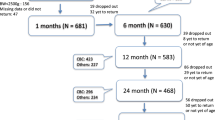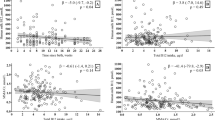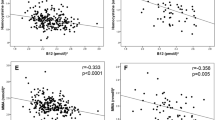Abstract
Objective:
To investigate the relation between lactation and markers of folate and vitamin B12 (B12) deficiency in women with and without vitamin supplementation.
Design:
A 9-month follow-up study.
Subjects and methods:
Blood samples from 91 women, who gave birth to a single healthy child, were collected 3 weeks, 4 and 9 months postpartum and analysed for circulating level of homocysteine (tHcy), methylmalonic acid (MMA), folate and B12. The participants were categorized as exclusively, partly or not breast-feeding dependent on the degree of lactation 4 months postpartum. During follow-up, lifestyle factors were recorded by structured interviews.
Results:
Among 72 exclusively breast-feeding women, the median (10–90% percentile) tHcy was 5.8 (3.1–8.3) μmol/l 3 weeks postpartum, 6.1 (4.1–10.3) μmol/l 4 months postpartum and 5.3 (3.6–8.7) μmol/l 9 months postpartum. At 9 months postpartum, none of the women breast-fed exclusively. No significant change occurred in the concentration of B12 and folate. Exclusively breast-feeding women without vitamin supplementation had higher median tHcy than supplemented exclusively breast-feeding women 4 and 9 months postpartum (7.0 vs 5.4 μmol/l (P<0.001) and 5.8 vs 4.5 μmol/l (P=0.003), respectively). Six women had increased (>15 μmol/l) tHcy; four of these were unsupplemented and exclusively breast-feeding.
Conclusion:
We found no overall indication of depletion of the folate and B12 stores during the lactation period in this population. However, folate-supplemented women had lower tHcy and higher folate levels, suggesting a beneficial effect of supplementation with folate throughout lactation.
Sponsorship:
The Biomedical Laboratory Scientist Education and Research Fund and LEO Pharma Research Foundation supported this study. DPC Scandinavia, Denmark donated reagents for the folate and tHcy analysis.
This is a preview of subscription content, access via your institution
Access options
Subscribe to this journal
Receive 12 print issues and online access
$259.00 per year
only $21.58 per issue
Buy this article
- Purchase on Springer Link
- Instant access to full article PDF
Prices may be subject to local taxes which are calculated during checkout


Similar content being viewed by others

References
Allen LH (1994). Vitamin B12 metabolism and status during pregnancy, lactation and infancy. Adv Exp Med Biol 352, 173–186.
Allen RH, Stabler SP, Savage DG, Lindenbaum J (1990). Diagnosis of cobalamin deficiency I: usefulness of serum methylmalonic acid and total homocysteine concentrations. Am J Hematol 34, 90–98.
Andersson A, Hultberg B, Brattstrom L, Isaksson A (1992). Decreased serum homocysteine in pregnancy. Eur J Clin Chem Clin Biochem 30, 377–379.
Bates CJ, Fuller NJ, Prentice AM (1986). Folate status during pregnancy and lactation in a West African rural community. Hum Nutr Clin Nutr 40, 3–13.
Bjorke Monsen AL, Ueland PM (2003). Homocysteine and methylmalonic acid in diagnosis and risk assessment from infancy to adolescence. Am J Clin Nutr 78, 7–21.
Brattstrom L (2003). Pregnancy-related decrease in total plasma homocysteine. Am J Clin Nutr 77, 993–994.
Bruinse HW, van der BH, Haspels AA (1985). Maternal serum folacin levels during and after normal pregnancy. Eur J Obstet Gynecol Reprod Biol 20, 153–158.
Butte NF, Calloway DH, Van Duzen JL (1981). Nutritional assessment of pregnant and lactating Navajo women. Am J Clin Nutr 34, 2216–2228.
Chery C, Barbe F, Lequere C, Abdelmouttaleb I, Gerard P, Barbarino P et al. (2002). Hyperhomocysteinemia is related to a decreased blood level of vitamin B12 in the second and third trimester of normal pregnancy. Clin Chem Lab Med 40, 1105–1108.
Cikot RJ, Steegers-Theunissen RP, Thomas CM, de Boo TM, Merkus HM, Steegers EA (2001). Longitudinal vitamin and homocysteine levels in normal pregnancy. Br J Nutr 85, 49–58.
Cole JK, Kimber RJ, Kutkaite D (1974). Serum folic acid levels and pregnancy in South Australia. A study of the factors associated with low serum folic acid levels with particular reference to racial groups and lactation. Med J Aust 1, 421–424.
Danish Veterinary and Food Administration (1997). Folat og neuralrørsdefekt. Schultz bogtryk: Copenhagen, Denmark.
Donangelo CM, Trugo NM, Koury JC, Barreto Silva MI, Freitas LA, Feldheim W et al. (1989). Iron, zinc, folate and vitamin B12 nutritional status and milk composition of low-income Brazilian mothers. Eur J Clin Nutr 43, 253–266.
Dostalova L (1984). Vitamin status during puerperium and lactation. Ann Nutr Metab 28, 385–408.
Ek J (1983). Plasma, red cell, and breast milk folacin concentrations in lactating women. Am J Clin Nutr 38, 929–935.
Gronbaeck MN, Iversen L, Olsen J, Becker PU, Hardt F, Sørensen TI (1997). Sensible drinking limits. Ugeskr Laeger 159, 5939–5945.
Hegaard HK, Kjaergaard H, Moller LF, Wachmann H, Ottesen BS (2004). The prevalence of passive smoking among pregnant women in Denmark on their first visit to the midwife. Ugeskr Laeger 166, 3706–3711.
Kang SS, Wong PW, Zhou JM, Cook HY (1986). Total homocyst(e)ine in plasma and amniotic fluid of pregnant women. Metabolism 35, 889–891.
Keizer SE, Gibson RS, O'Connor DL (1995). Postpartum folic acid supplementation of adolescents: impact on maternal folate and zinc status and milk composition. Am J Clin Nutr 62, 377–384.
Klee GG (2000). Cobalamin and folate evaluation: measurement of methylmalonic acid and homocysteine vs vitamin B(12) and folate. Clin Chem 46, 1277–1283.
Lehti KK (1989). Iron, folic acid and zinc intakes and status of low socio-economic pregnant and lactating Amazonian women. Eur J Clin Nutr 43, 505–513.
Mackey AD, Picciano MF (1999). Maternal folate status during extended lactation and the effect of supplemental folic acid. Am J Clin Nutr 69, 285–292.
Matoth Y, Pinkas A, Sroka C (1965). Studies on folic acid in infancy. 3. Folates in breast fed infants and their mothers. Am J Clin Nutr 16, 356–359.
Metz J (1970). Folate deficiency conditioned by lactation. Am J Clin Nutr 23, 843–847.
Michaud JL, Lemieux B, Ogier H, Lambert MA (1992). Nutritional vitamin B12 deficiency: two cases detected by routine newborn urinary screening. Eur J Pediatr 151, 218–220.
Moller UK (2003). Calcium homostase og knogleomsætning under og efter amning. Thesis, Protokol i forbindelse med speciale på Aarhus Universitet.
Murphy MM, Scott JM, McPartlin JM, Fernandez-Ballart JD (2002). The pregnancy-related decrease in fasting plasma homocysteine is not explained by folic acid supplementation, hemodilution, or a decrease in albumin in a longitudinal study. Am J Clin Nutr 76, 614–619.
O'Connor DL (1994). Folate status during pregnancy and lactation. Adv Exp Med Biol 352, 157–172.
O'Connor DL, Green T, Picciano MF (1997). Maternal folate status and lactation. J Mammary Gland Biol Neoplasia 2, 279–289.
Ramlau-Hansen CH, Moller UK, Moller J, Thulstrup AM (2003). Lactation – a risk factor for elevated plasma homocysteine? Ugeskr Laeger 165, 2819–2823.
Rasmussen K, Moller J (2000). Total homocysteine measurement in clinical practice. Ann Clin Biochem 37, 627–648.
Rasmussen K, Moller J, Lyngbak M (1999). Within-person variation of plasma homocysteine and effects of posture and tourniquet application. Clin Chem 45, 1850–1855.
Rasmussen K, Moller J, Lyngbak M, Pedersen AM, Dybkjaer L (1996). Age- and gender-specific reference intervals for total homocysteine and methylmalonic acid in plasma before and after vitamin supplementation. Clin Chem 42, 630–636.
Refsum H, Smith AD, Ueland PM, Nexo E, Clarke R, McPartlin J et al. (2004). Facts and recommendations about total homocysteine determinations: an expert opinion. Clin Chem 50, 3–32.
Refsum H, Ueland PM, Nygard O, Vollset SE (1998). Homocysteine and cardiovascular disease. Annu Rev Med 49, 31–62.
Salmenpera L, Perheentupa J, Siimes MA (1986). Folate nutrition is optimal in exclusively breast-fed infants but inadequate in some of their mothers and in formula-fed infants. J Pediatr Gastroenterol Nutr 5, 283–289.
Shapiro J, Alberts HW, Welch P, Metz J (1965). Folate and vitamin B-12 deficiency associated with lactation. Br J Haematol 11, 498–504.
Skajaa E (1992). Sundhedsprofil af småbørn og småbørnsfamilier i Århus – En deskriptiv undersøgelse af 3383 børn i 8-måneders alderen, 1992. Dansk institut for Sundheds – og Sygeplejeforening (report).
Smith AM, Picciano MF, Deering RH (1983). Folate supplementation during lactation: maternal folate status, human milk folate content, and their relationship to infant folate status. J Pediatr Gastroenterol Nutr 2, 622–628.
Smits LJ, Essed GG (2001). Short interpregnancy intervals and unfavourable pregnancy outcome: role of folate depletion. Lancet 358, 2074–2077.
Sneed SM, Zane C, Thomas MR (1981). The effects of ascorbic acid, vitamin B6, vitamin B12, and folic acid supplementation on the breast milk and maternal nutritional status of low socioeconomic lactating women. Am J Clin Nutr 34, 1338–1346.
Stabler SP, Allen RH (2004). Vitamin B12 deficiency as a worldwide problem. Annu Rev Nutr 24, 299–326.
Tamura T, Yoshimura Y, Arakawa T (1980). Human milk folate and folate status in lactating mothers and their infants. Am J Clin Nutr 33, 193–197.
Thomas MR, Sneed SM, Wei C, Nail PA, Wilson M, Sprinkle III EE (1980). The effects of vitamin C, vitamin B6, vitamin B12, folic acid, riboflavin, and thiamin on the breast milk and maternal status of well-nourished women at 6 months postpartum. Am J Clin Nutr 33, 2151–2156.
Villalpando S, Latulippe ME, Rosas G, Irurita MJ, Picciano MF, O'Connor DL (2003). Milk folate but not milk iron concentrations may be inadequate for some infants in a rural farming community in San Mateo, Capulhuac, Mexico. Am J Clin Nutr 78, 782–789.
Weiss R, Fogelman Y, Bennett M (2004). Severe vitamin B12 deficiency in an infant associated with a maternal deficiency and a strict vegetarian diet. J Pediatr Hematol Oncol 26, 270–271.
Acknowledgements
We thank the women who participated in the study, the staff at The Osteoporosis Clinic, Aarhus University Hospital, Denmark for collecting the blood samples, Lene Damm Christensen and the other staff at Department of Clinical Biochemistry, Aarhus University Hospital, Skejby, Denmark for analysing the blood samples, the secretaries at Department of Obstetrics and Gynaecology, Aarhus University Hospital, Skejby, Denmark for assisting during the identification of eligible women, Gurli Tanderup and DPC Scandinavia for providing reagents for the tHcy and folate analyses and finally The Biomedical Laboratory Scientist Education and Research Fund and LEO Pharma Research Foundation for their financial support.
Author information
Authors and Affiliations
Corresponding author
Additional information
Guarantor: CH Ramlau-Hansen.
Contributors: CHR, JM, UKM and TBH designed the study. CHR and UKM collected the samples. JM and EN were responsible for the biochemical analyses; CHR performed the statistical analyses, wrote the original manuscript and edited all subsequent versions. JM, EN and TBH contributed to the interpretation of data and commented on the manuscript. All authors approved the final version of the manuscript.
Rights and permissions
About this article
Cite this article
Ramlau-Hansen, C., Møller, U., Henriksen, T. et al. Folate and vitamin B12 in relation to lactation: a 9-month postpartum follow-up study. Eur J Clin Nutr 60, 120–128 (2006). https://doi.org/10.1038/sj.ejcn.1602275
Received:
Revised:
Accepted:
Published:
Issue Date:
DOI: https://doi.org/10.1038/sj.ejcn.1602275
Keywords
This article is cited by
-
A longitudinal study of serum cobalamins and its binding proteins in lactating women
European Journal of Clinical Nutrition (2007)


